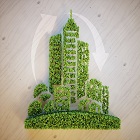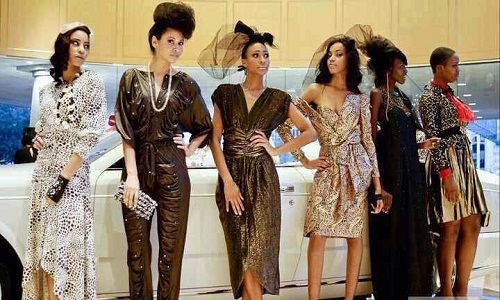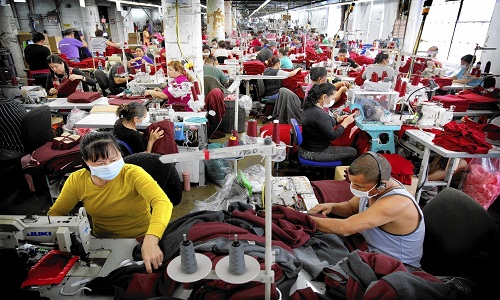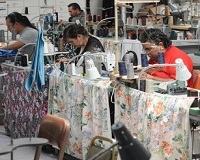FW
Turkey has made headway in cotton production. Availability of high quality seeds, an increase in number of harvesters and good farming practices has facilitated higher yields. Turkey became part of the Better Cotton Initiative three years ago. Turkish mills have been investing in new machinery and technology to increase quality and lower costs in order to get ahead in the very competitive international textile trade.
In 2015, domestic cotton consumption was about 1.47 million metric tons in spite of the lower textile exports. War conditions in Syria, Iraq and Ukraine, and the end of exports to Russia after the Turkish downing of a Russian plane in November 2015 resulted in a decline to these destinations. In the meantime, mills had to lower their margins to keep their market share in the European market to continue operating.
During the first 10 months of 2015 Bangladesh and Greece were the leading foreign destinations for Turkish cotton. Turkey also exported about 70,000 bales of hydrophilic cotton for medical use during the same period. Domestic consumption is expected to go up, even though marginally, during 2016 due to recent initiatives to improve relations with Russia and regional countries. Also, textile exports to Europe are expected to grow due to relative growth in the economies of the region.
"The entire value chain of clothing industry needs to dramatically shift gears to make it sustainable. Contrary to what is proclaimed by global brands, companies are still deploying production processes that are far from sustainable. A look at the startling statistics: In the US, 80 billion pieces of clothing are now purchased each year, 400 per cent more than two decades ago. The average American throws away 82 pounds of textile waste a year, mounting up to 11 million ton in the US alone."

The entire value chain of clothing industry needs to dramatically shift gears to make it sustainable. Contrary to what is proclaimed by global brands, companies are still deploying production processes that are far from sustainable. A look at the startling statistics: In the US, 80 billion pieces of clothing are now purchased each year, 400 per cent more than two decades ago. The average American throws away 82 pounds of textile waste a year, mounting up to 11 million ton in the US alone. In the UK, domestic clothing consumption has increased from one million ton in 2010 to 1.1 million in 2015, with England and Wales sending an estimated 620,000 ton to landfill (2013-14), worth an estimated £140 million, reveal WRAP’s ‘Textiles Market Situation Report’. Moreover, the average household owns around £4,000 worth of clothes, nearly a third of which hasn’t been worn for at least a year, meaning that UK consumers are hanging on to roughly £30 billion of unworn clothes, according to WRAP’s 2012 ‘Valuing Our Clothes’ report.

As per the WRAP report, textiles accounted for five per cent of UK’s total carbon and water footprint. Textiles manufacturing around the world (and mostly in developing countries) requires vast amounts of natural resources (1kg of cotton requires 20,000 litres of water), and often results in hazardous gases, pesticides & dyes being released into the environment.
New green initiatives
Indeed global associations are coming up with alternatives to reduce impact. Sustainable Clothing Action Plan (SCAP) by WRAP is among them, an initiative to ‘improve the sustainability of clothing across its lifecycle’. The signatories, representing 65 per cent of clothes sold in the UK by volume and 54 per cent by sales value, have committed to reducing carbon, water and waste to landfill per ton of clothing by 15 per cent by 2020, as well as reducing waste arising over the whole product lifecycle by 3.5 per cent. In November 2015, WRAP announced signatories have achieved reductions of 12.5 per cent for water and 3.5 per cent for carbon. A key part of SCAP’s work is focused on designs for longevity. WRAP says extending the active use of clothes by just nine months would reduce carbon, water and waste footprints by around 20-30 per cent each and cut resource costs by £5 billion.
Action plan for sustainable paradigms
While organic cotton and recycled polyester are widely known to be better for environment, there are plenty of other textile technologies that could lessen clothing’s impact. Traditional viscose manufacture, for instance, is currently in decline because of the high environmental costs. A few other manmade cellulosic fibres are coming to the fore, including lyocell, predominantly manufactured in Austria by Lenzig under the brand name Tencel. The process sees fast-growing Eucalyptus trees, grown on low-value land in South Africa, pulped with a recyclable solvent in a process that creates little waste, unlike traditional viscose manufacturing. Monocel, produced by Norwegian firm Nånkåtån, sees bamboo undergo a similar treatment to create another more sustainable viscose alternative.
Low-impact dyes is another important contributor. While environmental impact of dyeing depends on the type of dye, type of material, and application method, dyeing can be a polluting process, with the industry employing more than 8,000 chemicals, and requiring between 30 and 50 liters of water per kg of textile produced. Therefore, textile dyes need to be environmentally-friendly. Low-impact dye produced by AVITERA®, for instance, for use on cellulosic fibres (cotton, for the most part), can be used by conventional mills and reportedly requires 50 per cent less water and reduces CO2 emissions by 50 per cent or more during the dyeing and washing off processes, whilst also reducing processing time.
Huntsman company that manufactures chemicals says, if the entire world’s reactive dyed cotton was processed with AVITERA® SE, this could save more than 820 billion liters of water per year, equating to 1.3 liters of fresh water per person per day for the major textile processing countries like India, Bangladesh and China.
While not necessarily a technical innovation, changing consumer habits too need attention if fashion is to become sustainable. Consumption pattern need to undergo a dramatic shift. The lend-lease business model – part of the burgeoning sharing economy – is one that could certainly be expanded. There are examples such as Rentez-Vous in the UK, which bills itself as a ‘guilt-free unlimited wardrobe’, where users can list items of clothing that others can then rent for a set price and period of time. MUD Jeans, based in the Netherlands, has customers leasing jeans for life.
Some designers are working towards flexible single items of clothing. For example, Polish label Blessus creates modular constructions that allow customers to mix, match, or swap components using a series of concealed zippers to add or subtract pieces of fabric. Others are designing for disassembly (a wide known term in electronics), including Dutch companies Refinity and Dutchspririt, which have come up with the concept for a raincoat that can be disassembled for its components/materials after its first life. Refinity has also experimented with modular ‘fragment textiles’ that can be clicked together in various formations and removable prints that ‘combine short (fashion) cycles with long raw material cycles’. None of these are widely available.
China is now the second largest jeans market in the world where consumers’ affinity towards denim grew from 39 per cent in 2003 to 63 per cent in 2016, reveals a survey by Cotton Council International (CCI) and Cotton Incorporated’s 2016 Global Lifestyle Monitor shows. This has attracted many denim suppliers to partake in upcoming Intertextile Shanghai Apparel Fabrics – Autumn Edition 2016 to be held from October 11 to 13. Nearly 170 domestic and overseas exhibitors will showcase their newest denim collections.
Featuring five co-exhibitors, the new Lycra Moves Denim Pavilion by Invista will offer an interactive demonstration of its denim technologies including Lycra dualfx, Lycra Beauty and Coolmax as well as the latest Thermolite IR technology. Also hosted by Invista would be a panel discussion ‘Adding Value to Denim: Why this is a win for consumers and retailers’ to be held on October 12 at the new seminar area. The discussion will be moderated by fashion media Inside Fashion’s editorial director Jane Singer where four panelists will share their insights on different topics, like Consumer Insights, Evolution of Performance Denim, The Future of Denim, Stretch leads the trend, technology enhances performance. Intertextile Shanghai Apparel Fabrics – Autumn Edition 2016 is being co-organised by Messe Frankfurt (HK) Ltd., the Sub-Council of Textile Industry, CCPIT and the China Textile Information Centre.
"North Carolina, with 42,000 employed in 700 textile or apparel factories, has the largest textile mill industry in the US, says state’s Economic Development Partnership Organization (EDPNC). The EDPNC recruits US and foreign textile firms (among other industries) to invest in the state, marketing its integrated supply chain. While automation has become an essential part of the process, it can actually boost employment, explained Dan St Louis, executive director of Manufacturing Solutions Center, a non-profit in Conover, North Carolina focused on R&D, innovative technology, testing and incubator services for the apparel and textile industries."
North Carolina, with 42,000 employed in 700 textile or apparel factories, has the largest textile mill industry in the US, says state’s Economic Development Partnership Organization (EDPNC). The EDPNC recruits US and foreign textile firms (among other industries) to invest in the state, marketing its integrated supply chain. While automation has become an essential part of the process, it can actually boost employment, explained Dan St Louis, executive director of Manufacturing Solutions Center, a non-profit in Conover, North Carolina focused on R&D, innovative technology, testing and incubator services for the apparel and textile industries.

If an automated machine can increase production as a part of an effort to add more customers, then it can actually create jobs. In apparel sector, a company would have to add more sewers to keep up with increased production. Yet many manufacturers complain they can’t recruit qualified technicians or sewers because of the lingering and clichéd ‘sweatshop’ image that follows the textile industry.
Textile giants like Hanes, VF Corp and Gildan have headquarters in North Carolina, but they have moved their production offshore. The state lost thousands of jobs since the mid-1990s, a trend which started with the North Atlantic Free Trade Agreement (NAFTA). NAFTA, plus many other agreements such as Most Favored Nation (MFN) status from the World Trade Organization that eased trade restrictions from certain countries, on top of low labour wages in developing countries also fuelled offshore production. Because of these developments, local manufacturers were forced to compete with cheaper imports.
But Cluster Mapping has different facts to reveal. It says, textile jobs in North Carolina actually rose nearly 3 per cent between 2014 and 2015. Apparel jobs, however, fell just over 5 per cent for the same period. Burlington, part of ITG, has three factories weaving worsted wool and synthetic fabrics for clients including Brooks Brothers and the American army, which is restricted from procuring clothing that is not made in the US, among others. Brooks Brothers produces 6,000 button-down shirts weekly at its own Garland, North Carolina factory that currently employs 188 people — in a town of roughly 620 inhabitants — and is adding a third assembly line which should bring the employee count to over 200. The company is trying to develop a luxury performance knit with North Carolina mills for sports polo shirts and plans to make them in-state. This is part of the company’s drive to increase its ‘Made in America’ footprint.
Emphasis on ‘Made in US’
American Giant, the San Francisco-based maker of 100 per cent American-made sportswear recently bought three cut and sew factories in North Carolina to keep up with demand for its original product launched in 2012, an $89 cotton-fleece hoodie, and other goods. Two factories are expanding while the third is on hold, slated for a confidential 2018 joint venture. American Giant’s mid-range prices show that North Carolina and the US are capable of producing ‘exceptional product at a fair price’, not just high-end goods, said founder and chief executive Bayard Winthrop.
Then, there are multimillion-dollar investments from foreign entities into North Carolina. Dr David Hinks, Dean of the College of Textiles at North Carolina State University points out Sri Lanka-based MAS Holdings’ $20 million acquisition this year of Asheboro’s Acme-McCrary, a 108-year-old maker of hosiery, seamless apparel and active wear, and Taiwan’s Everest Textiles, a performance fabrics maker building an $18.5 million factory in Forest City. The state offers incentives to outside investors in the form of grants, worker training or tax benefits. There has been increasing interest by companies investing back into the US in textiles and apparel, especially in North Carolina.
What works for North Carolina
An Ipsos/Reuters study ‘Buy America’ conducted last spring shows, for 70 per cent of Americans Made in America goods are important to them. According to this year’s ‘Made in Country Index’ from Statista, US goods ranked No. 1 in reputation for consumers in six Latin American countries along with India, Egypt and the Philippines; and Made in the USA ranks 8th in the world.
With expectation for a fast response brands have to deliver quickly, which makes it essential for them to produce in the vicinity to avoid logistical delays. Moreover, manufacturers are exploring a new paradigm of reducing inventory liabilities and producing faster turnaround in place of the old model of a six-month manufacturing and delivery calendar. Offshore production can’t respond accordingly and North Carolina’s historical supply chain, among other textile manufacturing regions, can.
Bob Madore is the executive vice president and chief financial officer of American Eagle Outfitters. He will oversee all aspects of finance, merchandise planning and allocation and investor relations. Madore was the chief financial officer at Ralph Lauren, where he was instrumental in growing its global business across multiple channels, concepts and product categories.
He is known for his extensive financial and operational retail experience, global perspective and leadership. American Eagle Outfitters offers high quality, on trend clothing, accessories and personal care products for men and women under its American Eagle Outfitters and Aerie brands. The retailer targets men and women aged 15 to 25 and provides high quality apparel that can appeal to all demographics. American Eagle has a laid back aesthetic while remaining fashion forward and at an affordable price.
The company operates more than 1,000 stores in the United States, Canada, Mexico, China, Hong Kong and the UK. American Eagle Outfitters offers a bottoms collection, an assortment of other apparel categories, as well as footwear and accessories. Aerie is an intimates brand, offering bras, undies and swim wear. The Aerie brand operates approximately 100 stand-alone stores and over 70 side-by-side stores connected to American Eagle brand stores.
Egypt’s minister of trade and industry Tarek Kabil sees tremendous potential to enhance bilateral cooperation with India in textile, leather and automobile sector. He said this at a meeting with Tamil Nadu's Minister of Rural Industries P Benjamin who led the Indian delegation that participated in the recently concluded MACTECH Fair at the Cairo International Convention Centre.
India is Egypt's 10th largest export hub and the 10th largest import source. Hence, Egypt is keen to enhance economic cooperation with India in the SME sector. India's Ambassador to Egypt Sanjay Bhattacharyya disclosed both the sides discussed the possibilities of technology and investment cooperation in textiles and leather segment. India's participation with 50 companies at MACTECH Fair was to showcase the country’s strengths by delivering high quality, affordable prices and efficient utilisation of labour. Both sided also lok to increase exports and are looking at opportunities for joint ventures.
The delegation from the Engineering Export Promotion Council of India (EEPC India) comprised 50 leading Indian machine tools and technology organisations. The Indian Pavilion was organised by the EEPC, the premier trade and investment promotion group in engineering sector sponsored by the Ministry of Commerce and Industry, in association with the Embassy of India in Cairo.
Invista is going for a major expansion at its fiber manufacturing plant in South Carolina. A $30-million expansion of the plant will enable the company to rapidly respond to demands of small-lot carpet fiber. The investment represents the industry’s first-ever offering of one-step, small-lot capability, specifically for solution-dyed nylon 6,6. Invista developed this innovative, proprietary small-lot technology by working closely with equipment manufacturer Truetzschler.
According to Dirk Burger, CEO of the Truetzschler Group, his team was challenged and inspired to create enhanced products as a part of a long-term collaboration in research and development. He thanked Invista for its confidence on his company. The variety of small-lot nylon 6,6 fibers will initially be offered under Invista’s ‘Antron Lumena’ brand to serve the globally growing solution-dyed nylon BCF markets. Invista is one of world’s largest integrated producers of chemical intermediates, polymers and fibers. The company’s advantaged technologies for nylon, spandex and polyester are used to produce clothing, carpet, car parts and countless other everyday products.
Headquartered in the US, Invista operates in more than 20 countries and has about 10,000 employees. With about 3,000 employees worldwide and 150 employees in Charlotte NC, Trützschler is one of the world’s leading textile machinery manufacturers.
Same-store sales of Gap fell 4 per cent in September. Thus, the company missed analysts’ estimates of a 3.6 per cent year-over-year decline in sales. Gap’s shares dropped by 6.3 per cent in the first full-day of trading following the news. A number of analysts have weighed in on the stock. Jefferies Group reissued a buy rating on shares of Gap in a report of August 29. In a research report, Stifel Nicolaus gave a hold rating on shares of the company.
On the other hand, Vetr upgraded shares of Gap from a “sell rating to a hold rating and set a $25.65 target price on the stock in its research report. Credit Suisse Group AG restated a sell rating and set a $21.00 target price on shares of Gap in its research report. And finally, Canaccord Genuity restated a buy rating on shares of Gap.
Seven equities research analysts have rated the stock of Gap with a sell rating, twenty-six have assigned a hold rating, five have issued a buy rating and one has issued a strong buy rating to the company’s stock. The stock currently has an average rating of “Hold” and an average price target of $24.94.
A number of hedge funds have recently added to or reduced their stakes in GPS. Tobam raised its stake in Gap by 76.2 per cent in the first quarter. It now owns 1,348,416 shares of the apparel retailer’s stock valued at $39,644,000 after buying an additional 583,342 shares during the last quarter. Franklin Resources Inc. raised its stake in Gap by 1.8 per cent in the first quarter. Franklin Resources Inc. now owns 5,238,420 shares of the apparel retailer’s stock valued at $154,010,000 after buying an additional 94,400 shares during the last quarter. FDO Partners LLC bought a new stake in Gap during the first quarter valued at about $330,000.
With rising cotton prices, farmers are encouraged to increase inputs, therefore, production is expected to soar in Pakistan this year, US officials claim. Despite trimming its estimate of harvested area to the lowest level in three decades, the US Department of Agriculture (USDA)'s bureau in Islamabad upped its forecast for production of cotton.
According to the bureau rising cotton prices are prompting farmers to more actively manage insects, resulting in higher expected yields compared to a year ago when low cotton prices prompted farmers to curb input costs despite reduced planted area. The bureau has forecast cotton production in Pakistan would be at 8.25m 480 lb bales, up 250,000 bales from the earlier estimate and up 18 per cent year-on-year. Prices remained low at the time of planting this season, between May and July, prompted farmers to cut sown acres to their lowest levels since 1985.
The bureau saw harvested area this year at just 2.40m hectares, down from an official USDA estimate of 2.50 m hectares, and well below the 2.80 harvested last year. But cotton prices have been rising with the bureau reporting that seed cotton prices now stand at 37 cents a pound up some 48 per cent year-on-year. Thus where last year farmers cut costs by reducing pesticide application that resulted in tanking yields of the commodity, now there is a strong incentive to grow cotton.
Based on updated figures, the bureau has forecast cotton yields at 3.4 bales per hectare compared to 2.5 bales per hectare in 2015-16, an increase of 36 per cent. But despite the stronger production, with consumption remaining essentially flat at 10.33m bales, the bureau actually upgraded its forecast for imports by some 200,000 bales.
Suppliers of clothing who benefit from duty-free access to the UK might suffer due to Brexit unless special terms of access are negotiated, says a Textiles Intelligence report. It said suppliers in major clothing exporting countries like Bangladesh could be excluded from preferential access to the UK market when Britain leaves the European Union (EU).
After the historical poll that chose Brexit by 52 per cent to 48 per cent, UK has decided to come out from European Union. The exit process would take approximately two years as per a EU law mentioned in Article 50. In 2015, the UK was the EU's second largest clothing import market in value terms after Germany with a 17.7 per cent share of EU clothing imports into all member states. Bangladesh exported more than $3.5 billion to UK in 2015, and of the total export to UK, RMG goods accounted for over 50 per cent share ($1.62 billion)
Because the UK is a member of the EU, exporters in many developing countries including Bangladesh, Cambodia, Myanmar, Pakistan and Peru, enjoy duty-free access to the UK textile and clothing market under arrangements of the EU's Generalised Scheme of Preferences (GSP). But if and when the UK leaves the EU, imports into the UK from countries such as Bangladesh and Cambodia will, by default, be subject to a common external tariff as declared to the World Trade Organization (WTO).













